History
It was constructed between 1495 and 1501 by Guglielmo Ajutamicristo, Baron of Misilmeri and Calatafimi. Originally a merchant from a Pisan family, Ajutamicristo made his fortune trading in Sicilian cheese and cereals. The palazzo was built to celebrate and display the family's newly amassed wealth.
The architect selected was the eminent Matteo Carnilivari and a site chosen in the street now called Via Garibaldi, close to the now demolished Termini Gate. The original plan was for a far larger and extravagant house; however, these plans had to be modified and financial restraint exercised. Thus, the completed house was smaller than originally intended.
In spite of its reduced size the house became a centre of Sicilian high society, and was considered a residence superior to Palermo's royal palace. As a consequence, the Ajutamicristos entertained many leading political figures of the day: the Queen of Naples was entertained in great style at the house in 1500, and the Emperor Charles V in 1535.
The Ajutamicristo's ownership of the house was to be short-lived, and in 1588 the owner, Margherita Ajutamicristo, sold the building to Francesco Moncada, Ist Prince of Paternò. The property remained in the ownership of the Paternò family for two hundred years until the 18th century when it was sold to Baron Calefati di Canalotti in whose family it has remained until the present day.
The Calefati family had many of the salons remodelled. Of particular note is the frescoed ballroom with its ceiling painted by Giuseppe Crestadoro depicting The Glory of the Virtuous Prince.
Presently the palace has multiple uses, including private residence of the Calefati family, bedrooms can be rented at a bed and breakfast, and the piano nobile or courtyard may be rented for private functions.

The Chiaramonte are a noble family of Sicily. They became the most powerful and wealthy family in Sicily. In the 13th century the marriage of Manfredi Chiaramonte to Isabella Mosca, united the two Sicilian counties of Modica and Ragusa. Around 1307–1320, the couple built the family seat, the Palazzo Chiaramonte, in Palermo.

Sicilian Baroque is the distinctive form of Baroque architecture which evolved on the island of Sicily, off the southern coast of Italy, in the 17th and 18th centuries, when it was part of the Spanish Empire. The style is recognisable not only by its typical Baroque curves and flourishes, but also by its grinning masks and putti and a particular flamboyance that has given Sicily a unique architectural identity.
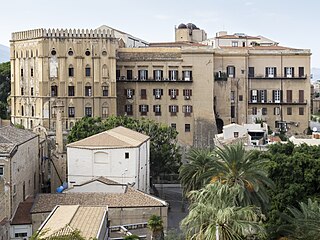
The Palazzo dei Normanni or Royal Palace of Palermo is a palace in Palermo, Italy. It was the seat of the Kings of Sicily with the Hauteville dynasty and served afterwards as the main seat of power for the subsequent rulers of Sicily. Since 1946 it has been the seat of the Sicilian Regional Assembly. The building is the oldest royal residence in Europe; and was the private residence of the rulers of the Kingdom of Sicily and the imperial seat of Frederick II and Conrad IV.
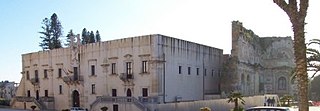
Santa Margherita di Belice is a town in the Province of Agrigento in the Italian region of Sicily. It lies in southwest Sicily, 400 metres (1,300 ft) above sea level, near where the borders of the Province of Agrigento, Province of Trapani and Province of Palermo meet. It is approximately 60 kilometres (37 mi) southwest of the city of Palermo, 60 kilometres (37 mi) northwest of the city of Agrigento and sits in the Belice valley among the rivers Belice, Senore and Carboj.

The Villa Spedalotto is the country home of the Paternò di Spedalotto family. The villa is situated on a hill surrounded by olive groves at Bagheria, near Palermo in Sicily. As all the Villas in Bagheria, it was built as a country house, and was traditionally used by the family only during the spring and autumn. While considered a national monument, it remains a private residence.
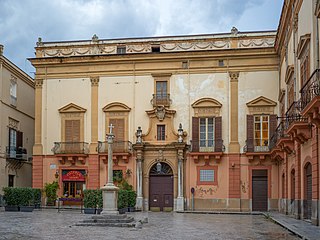
Palazzo Valguarnera-Gangi is an urban palace, first of the Princes Valguarnera and then of the Princes Gangi, situated in the Piazza Croce dei Vespri, in the ancient quarter of the Kalsa in the city of Palermo, region of Sicily, Italy. The palace still retains its original rich Rococo interior decoration, and is located a block south of the church of Sant'Anna la Misericordia.

The Palazzo Filangeri-Cutò was a palace built in the 17th century by the Corberas, a noble family of Spanish origin, in the small Sicilian town of Santa Margherita di Belice. The palace provided the setting for Giuseppe Tomasi di Lampedusa's celebrated novel The Leopard, which traced the evolution of Sicilian aristocracy in the 19th century.
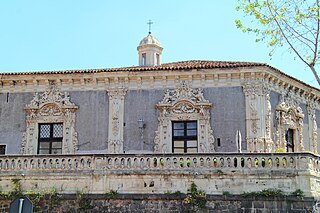
The Palazzo Biscari is a monumental private palace located on Via Museo Biscari in Catania, Sicily, southern Italy. The highly decorative interiors are open for guided tours, and used for social and cultural events.
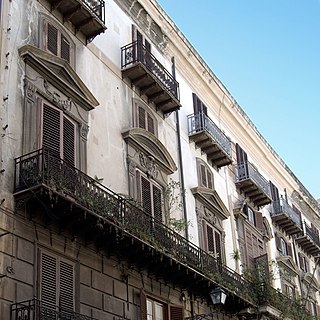
Palazzo Isnello is an historic palazzo situated between the ancient via del Cassaro and Piazza Borsa, in the Kalsa quarter of Palermo, Sicily.
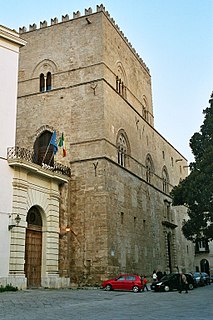
Palazzo Chiaramonte-Steri is a Gothic-style palace located on via Piazza Marina, facing the Giardino Garibaldi in the ancient quarter of Kalsa of Palermo, region of Sicily, Italy.

The Palazzo Clary is a Late Renaissance Venetian palace facing the Giudecca Canal alongside the fondamenta Zattere by the ponte longo in Venice's Dorsoduro. It was originally built in the 17th century for a Venetian noble family. In the early 19th century, the palazzo is known as Palazzo Clary, named after it was bought by the prince Clary-Aldringen. The neighboring building is Palazzo Giustinian Recanati.

Palazzo Parisio, formerly known as Scicluna Palace, Palazzo Scicluna, and officially Palazzo Parisio and Gardens, is a 20th-century palace in Naxxar, Malta. On site was a hunting lodge built in 1733 by Paolo Parisio, and was used as a summer or permanent residence, barracks and a college, before being acquired by the Marquis Scicluna in 1898.

Palazzo Fraccia is a mansion in the town centre of Alcamo, in the province of Trapani.

Palazzo Rossotti-Chiarelli, dating back to the 18th century, is located in via Rossotti in Alcamo, in the province of Trapani. It is in via Rossotti: in the same street you can also visit the Chiesa del Santissimo Salvatore(o Badia Grande).
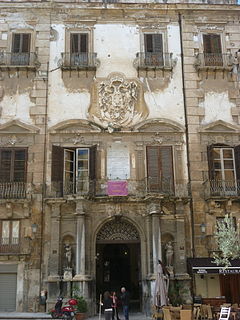
The Palazzo Alliata di Villafranca is former aristocratic mansion, now converted into a museum, located just off Via Vittorio Emanuele facing the Piazza Bologni which opens two blocks west of the Quattro Canti intersection, in the ancient quarter of the Albergaria of the city of Palermo, region of Sicily, Italy.
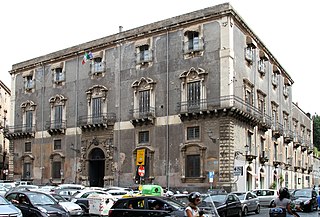
The Palazzo Manganelli is a Baroque monumental palace located in Piazza Manganelli, in the center of the city of Catania, region of Sicily, southern Italy. It is still lived in by heirs of the family, and also houses a hotel. The busy piazza serves mainly as a parking lot; at the north is a civic art gallery, housed in the former church of San Michele Minore. To the south, across Via Antonino di Sangiuliano stands the Teatro Sangiorgi. At one time, a building here housed the Istituto per la Educazione delle Fanciulle.

The Palazzo Paternò del Toscano, also known as the Palazzo del Toscano, is an notable palace in Piazza Stesicoro, in the center of Catania, region of Sicily, southern Italy. The building now houses many shops, but is also used by schools, and for cultural programs. The white stone facade stands before the Monument to Vincenzo Bellini and rises in contrast to the palace across via Aetna, the white and black Palazzo Tezzano.

Villa Zito is an 18th-century palace located on Via della Liberta #52 in Palermo, region of Sicily, Italy. The structure is now owned by the Fondazione Sicilia and serves as their the museum gallery and exhibition space for their collection of artworks, mainly graphic works and paintings, by mainly Sicilian artists from the 17th to the early 20th century.
The Palazzo Filangeri-Cutò is a Baroque-style aristocratic palace located on via Maqueda 26 in the ancient quarter of Albergheria of central Palermo, region of Sicily, Italy. Once the urban palace of a wealthy and prominent family, since the 19th-century the palace has been subdivided into numerous apartments and businesses, and in dire need of restoration.
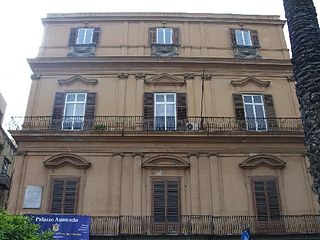
The Palazzo Asmundo is a late-Baroque aristocratic residence located on via Vittorio Emanuele, corner Via Pietro Novelli #3, in central Palermo, region of Sicily, Italy. The palace front faces the piazza and garden on the south flank of the Cathedral of Palermo. The privately owned palace is presently a museum and exhibition space.



















